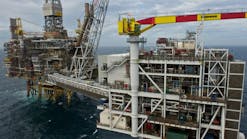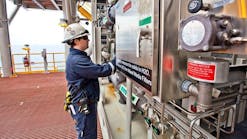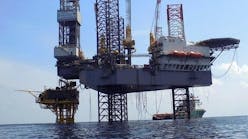Chevron has made a sixth new oil field discovery, Lobito-1X, situated in deepwater off Angola. The discovery is an elongate, NW-SE structure lying between the Landana and Tombacco fields, in the east of the company's Block 14 license. The well was drilled in 400 meters water depth off Cabinda.
During drill stem test, the well flowed at a rate of 10,200 b/d of high-quality, 35-degree API gravity oil. The discovery boosts Chevron's status as the ranking operator in Angola's oil industry. Even though the San Francisco-based major has the least areal coverage in both outright operatorship and equity interest in deepwater Angola, it has proved to be an efficient explorer.
For all the hype about the prolificity of the Angolan deepwater, Chevron is the only company that has put a field on stream. The firm's Kuito field, in production since the end of 1999, is currently producing 70,000 b/d. And apart from Kuito, Landana, Lobito and Tombacco, Chevron also has Belize and Benguela. Development plans are at an advanced stage for Benguela/Belize, with tendering of a contract expected shortly for front-end engineering and design.
"Block 14 is proving to be an outstanding asset for Chevron," said Peter Robertson, President of Chevron Overseas Petroleum Inc. "We intend to continue our aggressive approach of quickly moving the Block 14 discoveries into production. This commitment is reflected in the Angola investment plans of Chevron and its partners, which will total approximately $6 billion over the next five years."
Mark Puckett, Managing Director of Chevron's Southern Africa Strategic Business Unit, headquartered in Angola's capital of Luanda. "The Lobito discovery will dovetail well with our overall plan to develop the multiple commercial finds in the block."
The Tomboco Field was discovered earlier this year and had a combined test rate of more than 17,000 b/d of high-quality crude oil from two separate zones. While development plans are still in the early stages, the Lobito and Tomboco fields provide potential synergies with the Benguela/Belize development.
Block 14 covers 1,560 square miles and is located west of and adjacent to the 2,100-square-mile Block 0 Concession, offshore Angola's Cabinda province. With Chevron as operator, production from both blocks reached a record level of 550,000 barrels of oil per day earlier this year. Operatorship of Block 14 was awarded to Chevron in 1995, and drilling began in 1996.
Chevron holds a 3% interest in Block 14; SONANGOL, Agip Angola, and TotalFinaElf-Angola each hold a 20% interest. The remaining 9% interest is held by Petrogal.
Gabon's deepwater blocks fail to attract interest
Apparently sensing operators' disinterest, the Gabonese Government has, for the third time, postponed the terminal date of application for leases in its current bidding round. Last month, the government moved the application deadline from 30 September 2000 to 15 January 2001. Ironically, most of the 22 blocks on offer are in deepwater, right on the West African segment of the "hot" South Atlantic.
The government was even forced to re-open EM2000, which was on offer with a 30 June deadline. EM2000 was one of three units withdrawn (the others being DM2000, & FM2000) to give "options" to unspecified companies. Operators' unwillingness to venture into Gabon's deepwater blocks stems from the fact that the wells drilled by TotalFinaElf at the fringes of deepwater have not found anything and so companies are not in a hurry to look deeper.
West African discoveries tend to go from onshore and then into deeper waters gradually, and operators won't hesitate to move into greater depths, if something is found. "All this can change if something is found anywhere in the vicinity of these deepwater blocks," according to geologists working in Gabon's shelf blocks. An example is what occurred in the Rio Muni basin, where the Triton discovery changed perceptions on the area.
Akpo getting more mileage
Nigerian independent, South Atlantic Petroleum, was drilling the second appraisal of the deepwater oil field, Akpo, as of mid-Otober. Akpo 3, located in the western lobe of the structure was spudded in late September. The rig drilling is the semisubmersible Sedco 709. South Atlantic Petroleum holds a 60% stake in lease OPL 246, which contains the field. Total Upstream Nigeria, a subsidiary of the French major TotalFinaElf is technical adviser, with 24%, and it is drilling the wells on behalf of South Atlantic and the other partner Petrobras (16%). All the partners are maintaining confidentiality on information, but the broad, anticlinal field, located in 1,200 meters water depth, is widely reported to hold at least 600 million bbl. The rig was released from Akpo 2 in September.
Alba gas development successful
CMS Oil and Gas Company tested and completed a natural gas development well in the Alba field off Equatorial Guinea as part of an accelerated development project in the field. The Alba #7 well encountered 266 ft of gas sands and tested at rates of 53 MMcf/d of gas and 3,000 b/d of condensate. Drilling of the Alba # 8 well has begun.
The wells are part of the company's accelerated development project begun in 1999 to increase capacity from 90 MMcf/d to 225 MMcf/d of gas. About 115 MMcf/d of gas will be supplied to a methanol production plant under construction on Bioko Island. Another 10 MMcf/d will be used for onshore operations and the remainder will be re-injected offshore.
The field development consists of the engineering, fabrication, transportation and installation of a tripod well platform, a four-pile 12-slot manned platform with compression, various infield flow lines, a 19-mile pipeline from the Alba field to Bioko Island and drilling of several wells.
Chevron, NNPC move on halt to flaring
Chevron and the Nigerian National Petro-leum Corp. (NNPC) began an initiative to significantly reduce the amount of natural gas being flared in their joint venture operations. Under the initiative, $2 billion will be invested in two projects, the Escravos Gas Project Phase 3 and the Escravos Gas to Liquids development, both of which are targeted for completion in 2005. The gas-to-liquids facilities will combine technology from Sasol and Chevron. The projects will be built by Chevron and NNPC adjacent to the joint venture's existing operations at Escravos. The Escravos Gas Project Phase 3 will process about 400 MMcf/d of gas that is being produced along with crude and then flared. The plan will extract about 15,000 b/d of natural gas liquids and prepare the gas as feedstock for the gas to liquid facilities.
Ceiba appraisal well unsuccessful
Triton Energy's Ceiba-6 appraisal well off Equatorial Guinea was plugged and abandoned without encountering oil and gas shows based on analysis of initial logs. The Ceiba-6 was a significant step out well outside and southeast of the Ceiba field. It was drilled to 10,388 ft and was 2.5 miles south of the Ceiba-4 well. Prior to this latest well, Triton drilled five successful productive well in the Gulf of Guinea. The discovery well Ceiba-1 was in Block G. First oil production is expected by year-end from the first four wells drilled and completed in the field. Full-field production startup is expected by year end 2001 at a gross rate of 120,000 b/d. Although the Ceiba-6 well failed to encounter hydrocarbons, the well found new sands, both younger and older in geologic age than the main Ceiba reservoirs and may offer new exploration targets elsewhere in Blocks F and G. The Sedco 700 semisubmersible completed the Ceiba-4 well and is in the process of completing Ceiba 1, 2 and 3 wells. They will be hooked up to the FPSO Sendje Berge by year end at an initial prod-uction rate of 52,000 b/d.




